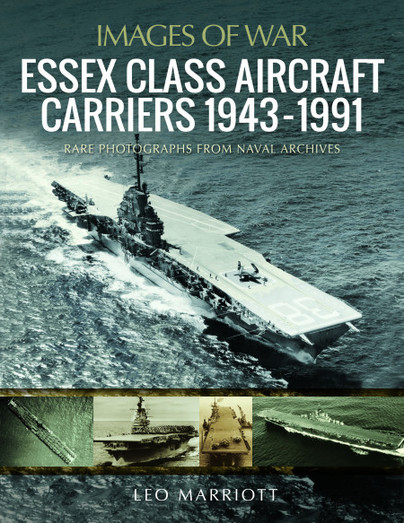Essex Class Aircraft Carriers 1943-1991
As a former carrier sailor, books on the history of these ships fascinate me, and both modelers and fans of the Essex-class carriers will enjoy this new release in the “Images of War” series from Pen and Sword in their Maritime line. There are some great photographs of the ships and their aircraft, along with some of astronaut recoveries. A total of 24 ships of the Essex-class were built and served well from World War II through Korea and Vietnam, with the last ship serving as a training carrier until 1991.
After a single page of Abbreviations and a Note on US Navy Ship Designations, the Introduction discusses the needs of the U.S. Navy following the attack on Pearl Harbor. It was fortunate that by the time of the attack that the Essex design had been finalized and that five hulls had been laid down. By the time of the Japanese surrender, 17 of these carriers had been commissioned and an additional seven would be completed after the war. The names of the 24 ships commissioned as well as the builders and dates of the hull being laid down, the launching and commissioning are all provided as are the two ships that had their hulls laid down but were not launched.
The nine chapters of the book are titles as follows, in order, US Navy Aircraft Carrier Development, 1919-1941; Essex Class Enter Service; Across the Pacific; Aboard the Essex Class; Through Kamikaze to Victory; The Post-War Era and Korea; Steam and Mirrors; Submarines, Spacecraft and Vietnam; and Postscript. The book ends with Photo Credits and a Bibliography. Also, on the cover is “Rare Photographs from Naval Archives”, and I can attest to seeing many for the first time in this book.
Like any great book on aircraft carriers, the author begins with the history of Naval Aviation and Eugene Ely flying a Curtiss plane to take off from a ship in November 1910, and then land on another in January of the following year. Photos of those events as well as the USS Langley (CV-1) and its later conversion to an aircraft transport (AV-3). Good coverage of the Lexington (CV-2), Saratoga (CV-3), and the first purpose-built carrier, Ranger (CV-4), as well as the Yorktown (CV-5), Enterprise (CV-6), Wasp (CV-7), and Hornet (CV-8) are represented in words and photographs. There is even a photo of some B-25 bombers tied down to the deck of the USS Hornet on their way to attack Tokyo.
While the Essex-class ships were to be similar to the Hornet, once the restrictions of the Washington Naval Treaty were dropped, the new class became 70 feet longer and 10 feet wider than the Yorktown-class ships. The ships were initially designed to carry 91 aircraft (36 fighters, 37 dive bombers, and 18 torpedo bombers), as the war continued, the ships often exceeded 100 planes being carried. A great mix of construction, underway, and aircraft photographs are included as well as items of interest like tow tractors in use on the flight deck and use of the hangar bay to hold troops during transports. Of interest to modelers will be shots of the ships carrying different camouflage patterns used during the war and aircraft in different paint schemes.
Photos of Korean War aircraft and the angled flight deck first appearing on the USS Antietam (CV-36) are included as well as a British Hawker Seahawk preparing to launch from this ship in 1953. Refits performed on the ships during their careers are mentioned, and photos of the flight decks filled with varying aircraft for submarine hunting and during Vietnam show the capabilities of the ships as they aged.
As mentioned at the start of this review, the book will be appreciated by both modelers and fans of aircraft carriers, so I highly recommend it. The interesting photographs aid in telling the story of a class of ships that served the US Navy for nearly 50 years. The photographs will certainly fuel inspiration for those wanting to represent the largest class of aircraft carriers built.
I always like to close by thanking the person in charge of the Review Corps, so hats off to Phil Peterson for his work, and to the folks behind the scenes like Bill O’Malley, who mails out the lion’s share of the review items, and the folks who place our reviews on the IPMS web site. In closing, an incredibly special thanks to the folks at Casemate Publishing for providing this book for review.

Reviewer Bio
Scott Hollingshead
Scott retired from the commercial nuclear industry with over thirty years of experience in Maintenance, Engineering, and Training. Prior to that he served on two aircraft carriers during his time in the U.S. Navy. He has been building models for over 50 years with his first kit being purchased with money from his grandparents for his sixth birthday. With a stash that consists of more aircraft than anything else, Scott still enjoys building a little bit of everything (including but not limited to tanks, cars, show cars, military vehicles (aside from tanks), ships, figures, real space, and some science fiction), which keeps his stash growing. Scott and his wife Fern reside in southwest lower Michigan, not far from South Bend, Indiana, and have three adult children and currently three grandchildren as well as a small dog and a large cat.






Comments
Add new comment
This site is protected by reCAPTCHA and the Google Privacy Policy and Terms of Service apply.
Similar Reviews